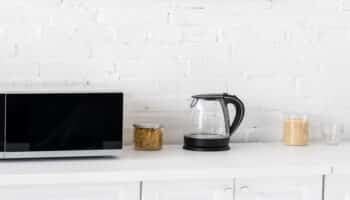Stuck trying to understand the differences between a toaster oven vs a microwave?
Both are fantastic appliances, but they do different things – you can’t replace or interchange one with the other.
So, your buying decision when faced with the two products is determined by what functionality you require.
The main difference between a toaster oven and a microwave is their cooking method. Toaster ovens use heating elements to generate heat, resulting in crispy food. Microwaves use electromagnetic waves to reheat your food quickly but don’t achieve the same level of browning and crispiness.
Read on to learn more about other differences between microwaves and toaster ovens.
Comparing Toaster Ovens vs Microwaves: 6 Key Differences
Understanding the main differences between a microwave and a toaster oven can be tricky.
Don’t worry, though – In this section, you’ll learn all the important details that set these appliances apart.
#1 Cooking Method
When comparing toaster ovens vs microwaves, it’s important to consider that both have different cooking methods.
Toaster ovens have heating elements that produce direct heat, making crispy and toasted food.
Microwaves, on the other hand, utilize a “magnetron” component to generate electromagnetic waves, which cause the water molecules in your food to vibrate, producing heat. Microwaves are ideal for reheating leftovers or even defrosting food. However, they aren’t effective at crisping food.
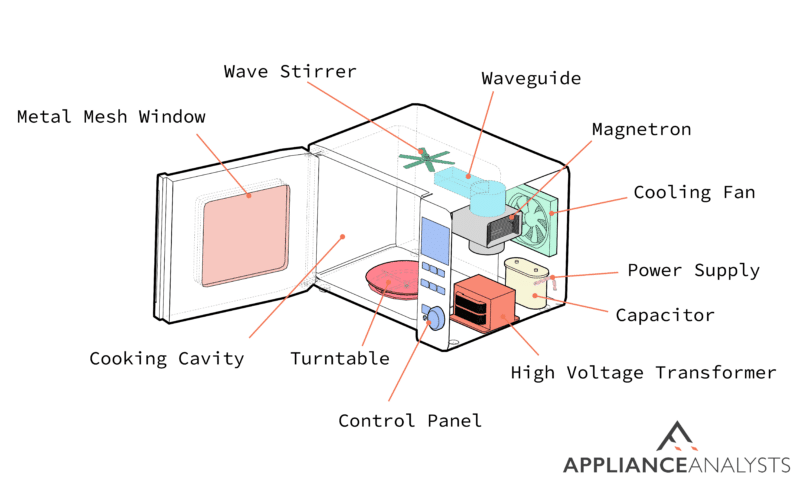
#2 Pricing
The price of toaster ovens and microwaves can vary depending on different factors. From what I’ve seen, as the number of features and the size of the unit increase, so does the price tag.
To compare the pricing of microwaves vs toaster ovens, I’ve prepared the following table, which includes estimated costs from major manufacturers.
Note: ‘– ‘indicates that the brand either doesn’t offer the product or no information could be found on it. The prices given are for stand–alone countertop appliances, not combination appliances or ‘over the range’ models.
| BRAND | MICROWAVE | TOASTER OVEN |
| Samsung | $200 – $400 | – |
| Whirlpool | $150 – $330 | – |
| Frigidaire | $90 – $250 | – |
| L.G | $150 – $260 | – |
| KitchenAid | Limited range – approx. $625 | $150 – $400 |
| Bosch | Only over-the-range models are available | – |
| Miele | $1 000 – $2 000 | – |
| General Electric | $160 – $740 | $130 – $140 |
| Smeg | Only built-in or OTR models are available | No countertop models made |
| Panasonic | $100 – $360 | – |
| Toshiba | $80 – $350 | $50 – $280 |
| Hamilton Beach | $55 – $150 | $60 – $140 |
| Black & Decker | $80 – $200 | $60 – $150 |
Bear in mind that these figures are correct at the time of writing but must be regarded as estimates.
Based on my research, Toshiba, Hamilton Beach, and Black & Decker offer the biggest ranges at the best prices, and they’re available at large retailers such as Walmart, so those brands are a good place to start when you’re shopping.
Availability or pricing will differ according to your region and the product specs, so check with your local appliance suppliers for the best deal!
#3 Features
When comparing toaster ovens vs microwaves, it’s important to consider their features.
As mentioned above, the two appliances are different, and both perform necessary functions in the kitchen.
A microwave oven is typically used for defrosting, reheating, steaming, and cooking. On the other hand, a toaster oven is generally used for things like toasting; baking; roasting, or slow-cooking things like casseroles or chili.
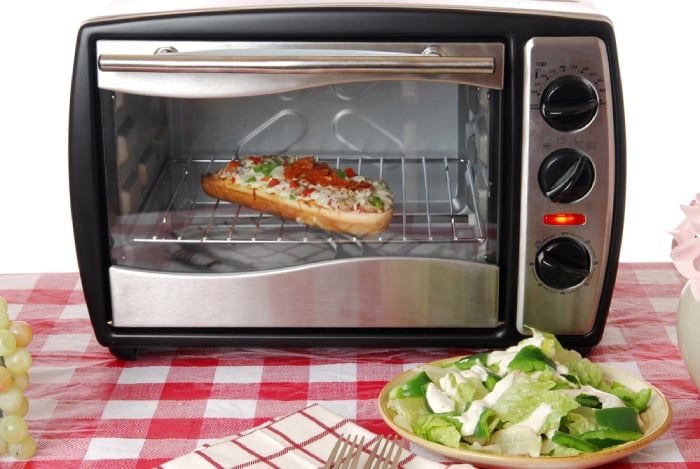
Toaster ovens and microwaves can give you loads of different types of meals. If you’re like me, you won’t want to eat the same thing every day, so you’ll use both interchangeably as your mood and needs change.
Also, let’s not forget the all-important morning staple of your toaster oven – golden, delicious toast! Toast is something your microwave can’t do, so it’s always best to have both appliances if your budget allows.
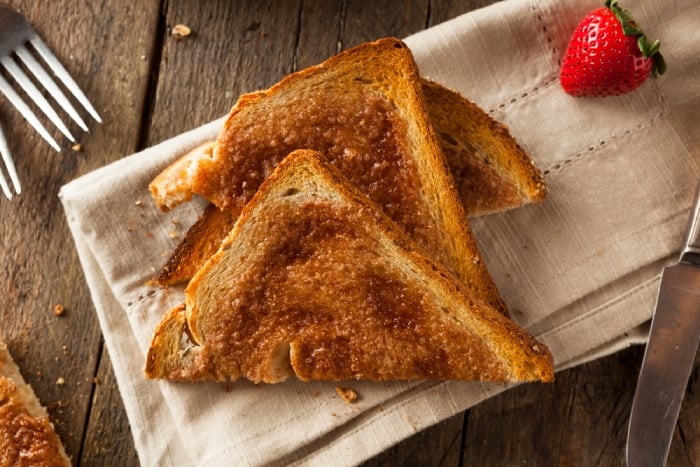
#4 Portability
Now, let’s talk about portability.
Your toaster oven and microwave* were built to be easily movable and portable between residences.
*Keep in mind that only countertop microwaves are portable. If you have a built-in model, you won’t be able to move it easily.
Additionally, both toaster ovens and countertop microwaves are space friendly. You can enjoy the convenience of microwave reheating and thawing and the longer and more in-depth cooking of an oven with a countertop toaster oven. As both fit onto standard kitchen-size counters, there’s no need for big amounts of overhead or wall space.
For clarity’s sake, even if you can access a long extension cord and an outdoor table, neither appliance should ever be used outdoors. Although the idea may be tempting, using them outdoors could damage your appliance, void your warranty, or cause an injury such as electrocution.
#5 Power Consumption
When choosing between a toaster oven vs a microwave, I always advise homeowners to consider the power consumption of both appliances.
An average-sized toaster oven uses approximately 1200 to 1400 watts. This is about a third to a half LESS energy than a normal-sized electric oven.
An average-sized microwave uses 600 to 1200 watts, which beats the toaster oven for energy saving. However, both appliances are energy efficient compared to larger appliances like fitted ovens or fridges.
Using your toaster oven for thirty minutes daily will cost you about $20 over a year, and using your microwave for 5 minutes daily will cost approximately $4 over a year*
*Keep in mind that the running costs will vary depending on the wattage, frequency of use, and electricity rate in your area.
Pro – tip: If you’re concerned about your power usage and perhaps, consider going for a smaller size unit, as it’ll use less power to achieve the same result.
#6 Ease of Cleaning
Now, let’s compare toaster ovens vs microwaves regarding ease of cleaning.
In my opinion, microwaves are easier to clean because the circulating plate is removable, and you can just take it out and wash it under your hot tap with some detergent.
On the other hand, toaster ovens have more components, such as racks, that can be harder to clean.
Tip: I recommend using a microwaveable steam/plate cover to avoid splatters and grease getting onto the microwave walls.
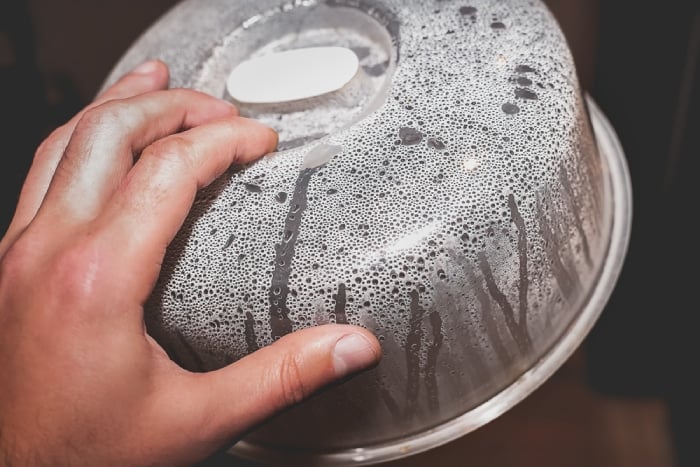
I always advise homeowners to avoid abrasive cleaners in their microwave or toaster ovens, as they can damage the finish of the appliance.
Always refer to the manufacturer’s manual before cleaning your toaster oven or microwave.
What is a Toaster Oven Better For?
In my experience, your toaster oven is better for cooking from scratch (with raw ingredients) and browning food. It’s also leagues ahead of a microwave for baking because of its browning ability.
Keep in mind that it’s nowhere near as fast as your microwave, but your food will be beautifully golden and cooked through to perfection.
What is a Microwave Oven Better For?
A microwave is faster and better for reheating already cooked food and for steaming raw ingredients in their own juices or added liquids like stock or water.
A microwave loses out to the toaster oven for browning and longer cooking processes like stewing and baking, but it can’t be beaten on speed, convenience, and energy efficiency.
FAQs on Toaster Ovens vs Microwaves
Can a Toaster Oven Replace a Microwave?
No, toaster ovens can’t replicate all the functions of microwaves because they work in different ways, and their cooking results vary.
For example, microwaves have specific settings for defrosting food. Toaster ovens typically don’t offer this feature.
Can I Put Aluminum Foil on a Toaster Oven?
Yes, you can, but be careful.
While putting aluminum foil inside a toaster oven is safe, you must always double-check that it doesn’t touch the heating element, as this could start a fire.
Ideally, you’ll want to leave as much space as possible between the foil and this component.
Is It Safe to Leave a Toaster Oven Plugged Into the Wall?
Unless your manufacturer specifies otherwise, yes.
That said, you should consider that the appliance will keep drawing power from the outlet, even when not used. Don’t worry; the power drawn will be minimal, but it can add up to a couple of bucks monthly.
So, if you want to save as much as possible in utilities and can’t sleep peacefully knowing the unit is plugged in, feel free to unplug it after using it.
What’s the Best Way to Clean a Toaster Oven?
First, let it cool down completely and unplug it from the wall.
Once you have done that, use a damp cloth to remove crumbs and stains from the unit’s interior. You can use a mixture of baking soda and water for tough stains.
Let the appliance dry completely before using it again, and you’re good to go!
Conclusion
Hopefully, now you know all the differences between microwaves and toaster ovens.
Remember, toaster ovens use heating elements to achieve a crispy texture in your food, while microwaves rely on electromagnetic waves to generate heat. Microwaves are easier to clean and faster at heating, but they don’t brown or toast food.
Both appliances have their own benefits and areas of expertise. I can’t say one is better than the other– it all depends on what type of cooking and eating you’re doing!
If you want to keep learning and like to support us, please check out our other articles below and join our newsletter.
See you next time!
— Craig.






